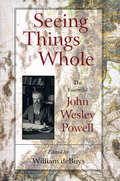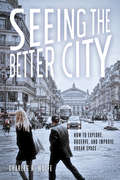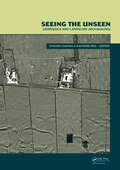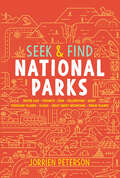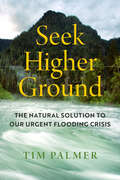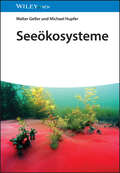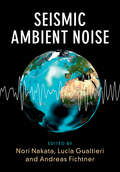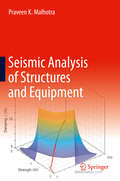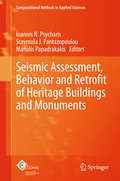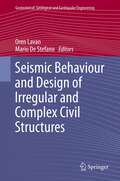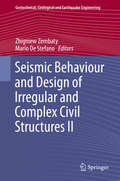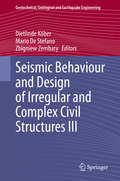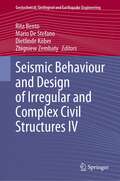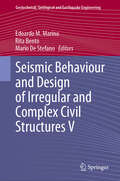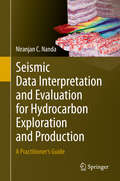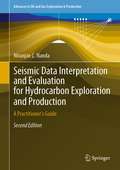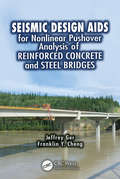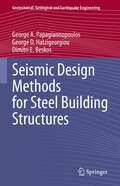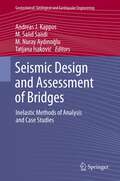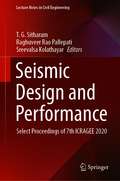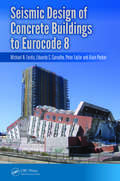- Table View
- List View
Seeing Smart Cities Through a Multi-Dimensional Lens: Perspectives, Relationships, and Patterns for Success
by H. Patricia McKennaThis book provides an interdisciplinary lens for exploring, assessing, and coming to new understandings of smart cities and regions, focusing on the six dimensions of sensing, awareness, learning, openness, innovation, and disruption. Using a hybrid case study and correlational approach, people from diverse sectors in a variety of small to medium to large-sized cities in multiple countries (e.g., Canada, United States, Ireland, Greece, Israel, etc.) provide experience-based perspectives on smart cities together with assessments for elements pertaining to each of the six dimensions.The analysis of findings in this work surfaces a rich and interwoven tapestry of patterns from the qualitative data highlighting for example, the importance of emotion/affect, privacy, trust, and data visualizations in influencing and informing the directions of smart cities and regions going forward. Correlational analysis of quantitative data reveals the presence and strength of emerging relationships among elements assessed, shedding light on factors that may serve as starting points for understanding what is contributing to potentials for improving success in smart cities and regions.
Seeing Things Whole: The Essential John Wesley Powell (Pioneers of Conservation)
by John Wesley Powell William DebuysJohn Wesley Powell was an American original. He was the last of the nation's great continental explorers and the first of a new breed of public servant: part scientist, part social reformer, part institution builder. His work and life reveal an enduringly valuable way of thinking about land, water, and society as parts of an interconnected whole; he was America's first great bioregional thinker.Seeing Things Whole presents John Wesley Powell in the full diversity of his achievements and interests, bringing together in a single volume writings ranging from his gripping account of exploring the Colorado River through the Grand Canyon to his views on the evolution of civilization, along with the seminal writings in which he sets forth his ideas on western settlement and the allocation and management of western resources.The centerpiece of Seeing Things Whole is a series of selections from the famous 1878 Report on the Lands of the Arid Region and related magazine articles in which Powell further develops the themes of the report. John Wesley Powell's bioregional vision remains a model for governance that many westerners see as a viable solution to the resource management conflicts that continue to plague the region.Throughout the collection, award-winning writer and historian William deBuys brilliantly sets the historical context for Powell's work. Section introductions and extensive descriptive notes take the reader through the evolution of John Wesley Powell's interests and ideas from his critique of Social Darwinism and landmark categorization of Indian languages to the climactic yet ultimately futile battles he fought to win adoption of his land-use proposals.Seeing Things Whole presents the essence of the extraordinary legacy that John Wesley Powell has left to the American people, and to people everywhere who strive to reconcile the demands of society with the imperatives of the land.
Seeing the Better City: How to Explore, Observe, and Improve Urban Space
by Charles R. WolfeIn order to understand and improve cities today, personal observation remains as important as ever. While big data, digital mapping, and simulated cityscapes are valuable tools for understanding urban space, using them without on-the-ground, human impressions risks creating places that do not reflect authentic local context. Seeing the Better City brings our attention back to the real world right in front of us, focusing it once more on the sights, sounds, and experiences of place in order to craft policies, plans, and regulations to shape better urban environments.Through clear prose and vibrant photographs, Charles Wolfe shows those who experience cities how they might catalog the influences of urban form, neighborhood dynamics, public transportation, and myriad other basic city elements that impact their daily lives. He then shares insights into how they can use those observations to contribute to better planning and design decisions. Wolfe calls this the "urban diary” approach, and highlights how the perspective of the observer is key to understanding the dynamics of urban space. He concludes by offering contemporary examples and guidance on how to use carefully recorded and organized observations as a tool to create change in urban planning conversations and practice.From city-dwellers to elected officials involved in local planning and design issues, this book is an invaluable tool for constructive, creative discourse about improving urban space.
Seeing the Unseen. Geophysics and Landscape Archaeology
by Salvatore Piro Stefano CampanaSEEING THE UNSEEN. GEOPHYSICS AND LANDSCAPE ARCHAEOLOGY is a collection of papers presented at the advanced XV International Summer School in ArchaeologyGeophysics for Landscape Archaeology (Grosseto, Italy, 10-18 July 2006). Bringing together the experience of some of the worlds greatest experts in the field of archaeological prospection, the
Seek & Find National Parks: Crater Lake, Yosemite, Zion, Yellowstone, Banff, Thousand Islands, Acadia, Great Smoky Mountains, Virgin Islands (Seek & Find)
by Jorrien PetersonLearn about the plants and animals in nine national parks with fun facts, engaging questions, and intricate illustrations.Explore your world top to bottom with Seek & Find National Parks to learn what makes each park totally unique. See if you can spot the recurring shapes hidden throughout the illustrations, such as bighorn sheep, American black bears, and giant sequoias. Seek and find these animals and plants, and many more in their national park homes. A helpful glossary provides details for further discovery. National parks featured include: Acadia (Maine), Banff (Alberta), Crater Lake (Oregon), the Great Smoky Mountains (Tennessee/North Carolina), Thousand Islands (Ontario), US Virgin Islands, Yellowstone (Wyoming/Montana/Idaho), Yosemite (California), and Zion (Utah).
Seek Higher Ground: The Natural Solution to Our Urgent Flooding Crisis
by Tim PalmerPairing in-depth journalism with historical perspectives, this book makes a compelling case for a natural solution to the growing problem of flooding. With Seek Higher Ground, environmental writer and former land-use planner Tim Palmer explores the legacy of flooding in America, taking a fresh look at the emerging climatic, economic, and ecological realities of our rivers and communities. Global warming is forecast to sharply intensify flooding, and this book urges that we reduce future damage in the most effective, efficient, and equitable ways possible. Through historical narrative, rigorous reporting, and decades of vivid personal experience, Palmer details how our society’s approach to flood control has been infamously inadequate and chronically counterproductive. He builds a powerful argument for both the protection of floodplain open space and for programs that help people voluntarily relocate their homes away from high-water hazards. Only by recognizing the indomitable forces of nature—and adapting to them—can we thrive in the challenging climate to come.
Seeökosysteme
by Walter Geller Michael HupferSeen sind ein zentraler Bestandteil der mitteleuropäischen Landschaften mit einem hohen Nutzwert für Wasserversorgung, Binnenfischerei, Freizeit und Artenschutz. Sie besitzen ein komplexes Ökosystem, das von vielen unterschiedlichen Faktoren wie Temperatur, Nährstoffeintrag sowie der Art und Anzahl der im See lebenden Mikroorganismen, Pflanzen und Tiere abhängt. Die Kenntnis aller dieser Faktoren und ihres Zusammenspiels ist die entscheidende Voraussetzung, um das Ökosystem See zu verstehen, zu überwachen und ggf. schützend einzugreifen, wenn dieses aus der Balance gerät. Diese umfassende Übersicht zur Ökologie von Seen basiert auf neuesten Erkenntnissen und zahlreichen wissenschaftlichen Studien aus den vergangenen zwei Jahrzehnten. Zunächst werden die abiotischen Faktoren wie Temperatur, Licht und Sauerstoffverhältnisse und deren Einfluss auf die Gliederung von Seen in unterschiedliche Habitate und ökologische Nischen beschrieben. Weitere Kapitel befassen sich mit den Organismen im See, vom Phytoplankton und Zooplankton bis hin zu höheren Pflanzen und Tieren, deren Populationsbiologie, sowie den daraus entstehenden ökologischen Netzen. Der Einfluss invasiver Arten wird anhand von mehreren Beispielen dokumentiert. Dieses Standardwerk zur Ökologie von Seen erklärt und dokumentiert anhand von umfangreichem Datenmaterial den Stand des Wissens und ist ein zuverlässiger Begleiter für Ausbildung und Beruf.
Seismic Ambient Noise
by Andreas Fichtner Nori Nakata Lucia GualtieriThe seismic ambient field allows us to study interactions between the atmosphere, the oceans and the solid Earth. The theoretical understanding of seismic ambient noise has improved substantially in the last decades, and the number of its applications has increased dramatically. With chapters written by eminent scientists from the field, this book covers a range of topics including ambient noise observations, generation models of their physical origins, numerical modelling and processing methods. The later chapters focus on applications in imaging and monitoring the internal structure of the Earth, including interferometry for time-dependant imaging and tomography. This volume thus provides a comprehensive overview of this cutting-edge discipline for graduate students studying geophysics and for scientists working in seismology and other imaging sciences.
Seismic Amplitude: An Interpreter's Handbook
by Rob Simm Mike BaconSeismic amplitudes yield key information on lithology and fluid fill, enabling interpretation of reservoir quality and likelihood of hydrocarbon presence. The modern seismic interpreter must be able to deploy a range of sophisticated geophysical techniques, such as seismic inversion, AVO (amplitude variation with offset), and rock physics modelling, as well as integrating information from other geophysical techniques and well data. This accessible, authoritative book provides a complete framework for seismic amplitude interpretation and analysis in a practical manner that allows easy application - independent of any commercial software products. Deriving from the authors' extensive industry expertise and experience of delivering practical courses on the subject, it guides the interpreter through each step, introducing techniques with practical observations and helping to evaluate interpretation confidence. Seismic Amplitude is an invaluable day-to-day tool for graduate students and industry professionals in geology, geophysics, petrophysics, reservoir engineering, and all subsurface disciplines making regular use of seismic data.
Seismic Analysis of Structures and Equipment
by Praveen K. MalhotraThis book describes methods used to estimate forces and deformations in structures during future earthquakes. It synthesizes the topics related to ground motions with those related to structural response and, therefore, closes the gap between geosciences and engineering. Requiring no prior knowledge, the book elucidates confusing concepts related to ground motions and structural response and enables the reader to select a suitable analysis method and implement a cost‐effective seismic design.Presents lucid, accessible descriptions of key concepts in ground motions and structural response and easy to follow descriptions of methods used in seismic analysis;Explains the roles of strength, deformability, and damping in seismic design;Reinforces concepts with real‐world examples;Stands as a ready reference for performance‐based/risk-based seismic design, providing guidance for achieving a cost-effective seismic design.
Seismic Assessment, Behavior and Retrofit of Heritage Buildings and Monuments
by Manolis Papadrakakis Ioannis N. Psycharis Stavroula J. PantazopoulouThis book assembles, identifies and highlights the most recent developments in Rehabilitation and retrofitting of historical and heritage structures. This is an issue of paramount importance in countries with great built cultural heritage that also suffer from high seismicity, such as the countries of the eastern Mediterranean basin. Heritage structures range from traditional residential constructions to monumental structures, ancient temples, towers, castles, etc. It is generally recognized that these structures present particular difficulties in seismic response calculation through computer simulation due to the complexity of the structural system which is, generally, inhomogeneous, with several contact problems, gaps/joints, nonlinearities and brittleness in material constituents. This book contains selected papers from the ECCOMAS Thematic Conferences on Computational Methods in Structural Dynamics & Earthquake Engineering (COMPDYN) that were held in Corfu, Greece in 2011 and Kos, Greece in 2013. The Conferences brought together the scientific communities of Computational Mechanics, Structural Dynamics and Earthquake Engineering in an effort to facilitate the exchange of ideas in topics of mutual interest and to serve as a platform for establishing links between research groups with complementary activities.
Seismic Behaviour and Design of Irregular and Complex Civil Structures
by Mario De Stefano Oren LavanStructural irregularities are one of the most frequent causes of severe damages in buildings, as evidenced by the numerous earthquakes in recent years. This issue is of particular importance, since real structures are almost all irregular. Furthermore, structural irregularities depend on several factors often very difficult to predict. This book is an essential tool for understanding the problem of structural irregularities and provides the most up-to-date review on this topic, covering the aspects of ground rotations, analysis, design, control and monitoring of irregular structures. It includes 24 contributions from authors of 13 countries, giving a complete and international view of the problem.
Seismic Behaviour and Design of Irregular and Complex Civil Structures II
by Mario De Stefano Zbigniew ZembatyIrregular engineering structures are subjected to complicated additional loads which are often beyond conventional design models developed for traditional, simplified plane models. This book covers detailed research and recent progress in seismic engineering dealing with seismic behaviour of irregular and set-back engineering structures. Experimental results as well as special topics of modern design are discussed in detail. In addition, recent progress in seismology, wave propagation and seismic engineering, which provides novel, modern modelling of complex seismic loads, is reported. Particular emphasis is placed on the newly developed rotational, seismic ground-motion effects. This book is a continuation of an earlier monograph which appeared in the same Springer series in 2013 (http://www. springer. com/gp/book/9789400753761).
Seismic Behaviour and Design of Irregular and Complex Civil Structures III (Geotechnical, Geological and Earthquake Engineering #48)
by Mario De Stefano Zbigniew Zembaty Dietlinde KöberThis book presents state-of-the-art knowledge on problems of the effects of structural irregularities on their seismic response. It also covers specific spatial and rotational seismic loads on these structures. Rapid progress in respective research on irregular structures and unconventional seismic loads requires prompt updates of the state of the art in this area. These problems are of particular interest to both researchers and practitioners because these are non-conservative effects compared with the approach of the traditional seismic design (e.g. Eurocode 8, Uniform Building Code etc.). This book will be of particular interest to researchers, PhD students and engineers dealing with design of structures under seismic excitations.
Seismic Behaviour and Design of Irregular and Complex Civil Structures IV (Geotechnical, Geological and Earthquake Engineering #50)
by Mario De Stefano Zbigniew Zembaty Dietlinde Köber Rita BentoThis volume contains papers of the 9th European Workshop on the Seismic Behaviour of Irregular and Complex Structures (9EWICS) held in Lisbon, Portugal, in 2020. This workshop, organized at Instituto Superior Técnico, University of Lisbon, continued the successful three-annual series of workshops started back in 1996. Its organization had the sponsorship of Working Group 8 (Seismic Behaviour of Irregular and Complex Structures) of the European Association of Earthquake Engineering.This international event provided a platform for discussion and exchange of ideas and unveiled new insights on the possibilities and challenges of irregular and complex structures under seismic actions. The topics addressed include criteria for regularity, seismic design of irregular structures, seismic assessment of irregular and complex structures, retrofit of irregular and complex structures, and soil-structure interaction for irregular and complex structures. Beyond an excellent number of interesting papers on these topics, this volume includes the papers of the two invited lectures – one devoted to irregularities in RC buildings, including perspectives in current seismic design codes, difficulties in their application and further research needs, and another one dedicated to the challenging and very up to date topic in the area of seismic response of masonry building aggregates in historical centers. This volume includes 26 contributions from authors of 11 countries, giving a complete and international view of the problem.The holds particular interest for all the community involved in the challenging task of seismic design, assessment and/or retrofit of irregular and complex structures.
Seismic Behaviour and Design of Irregular and Complex Civil Structures V (Geotechnical, Geological and Earthquake Engineering #53)
by Mario De Stefano Rita Bento Edoardo M. MarinoThis volume contains papers of the 10th European Workshop on the Seismic Behaviour of Irregular and Complex Structures (10EWICS) held in Catania, Italy, in 2023. This international event provided a platform for discussion and exchange of ideas and unveiled new insights on the possibilities and challenges of irregular and complex structures under seismic actions. The topics addressed include criteria for regularity and design of buildings with structural irregularity/complexity, assessment and retrofit of buildings with structural irregularity/complexity, irregularity /complexity in high-rise buildings, historical constructions and bridges, soil-structure interaction and special cases of irregularity. Beyond an excellent number of interesting papers on these topics, this volume includes the paper of an invited lecture devoted to rocking seismic resisting systems with focus to concepts, analysis, design, and applicability to irregular buildings. The book is intented for all the community involved in the challenging task of seismic design, assessment and/or retrofit of irregular and complex structures.
Seismic Control of Structures Using Tuned Mass Dampers: Theory and Practice (Synthesis Lectures on Engineering, Science, and Technology)
by Hamid Radmard RahmaniThis book begins by describing the Tuned Mass Dampers (TMD) systems to familiarize readers with the basic concepts, followed by a brief review of the state-of-the-art research findings culled from recent studies in the archival literature. In the third chapter, the applicable structural theories are discussed. Next, the authors examine some advanced and applicable optimization techniques, such as the Genetic Algorithm, and related computer algorithms and modeling techniques to help engineers and researchers in performing computer simulations. Examples from the field appear in the last chapter to reinforce the concepts presented. Instilling practical insight into the TMDs, their applications, basic theories, and modeling techniques, the book is ideal for practical engineers, researchers and students of structural engineering.
Seismic Data Interpretation and Evaluation for Hydrocarbon Exploration and Production
by Niranjan C. NandaThis book introduces readers to the field of seismic data interpretation and evaluation, covering themes such as petroleum exploration and high resolution seismic data. It helps geoscientists and engineers who are practitioners in this area to both understand and to avoid the potential pitfalls of interpreting and evaluating such data, especially the over-reliance on sophisticated software packages and workstations alongside a lack of grasp on the elementary principles of geology and geophysics. Chapters elaborate on the necessary principles, from topics like seismic wave propagation and rock-fluid parameters to seismic modeling and inversions, explaining the need to understand geological implications. The difference between interpretation of data and its evaluation is highlighted and the author encourages imaginative, logical and practical application of knowledge. Readers will appreciate the exquisite illustrations included with the accessibly written text, which simplify the process of learning about interpretation of seismic data. This multidisciplinary, integrated and practical approach to data evaluation will prove to be a valuable tool for students and young professionals, especially those connected with oil companies.
Seismic Data Interpretation and Evaluation for Hydrocarbon Exploration and Production: A Practitioner’s Guide (Advances in Oil and Gas Exploration & Production)
by Niranjan C. NandaThis book is meant for geoscientists and engineers who are beginners, and introduces them to the field of seismic data interpretation and evaluation. The exquisite seismic illustrations and real case examples interspersed in the text help the readers appreciate the interpretation of seismic data in a simple way, and at the same time, emphasize the multidisciplinary, integrated practical approach to data evaluation. A concerted effort has been made for the readers to realize that mindless interpretation of seismic data using sophisticated software packages, without having a grasp on the elementary principles of geology and geophysics, and coupled with their over-reliance on workstations to provide solutions can have appalling results all too very often.
Seismic Design Aids for Nonlinear Pushover Analysis of Reinforced Concrete and Steel Bridges (Advances in Earthquake Engineering)
by Franklin Y. Cheng Jeffrey GerNonlinear static monotonic (pushover) analysis has become a common practice in performance-based bridge seismic design. The popularity of pushover analysis is due to its ability to identify the failure modes and the design limit states of bridge piers and to provide the progressive collapse sequence of damaged bridges when subjected to major earthq
Seismic Design Methodologies for the Next Generation of Codes
by PETER FAJFAR AND HELMUT KRAWINKLERThese proceedings, arising from an international workshop, present research results and ideas on issues of importance to seismic risk reduction and the development of future seismic codes.
Seismic Design Methods for Steel Building Structures (Geotechnical, Geological and Earthquake Engineering #51)
by George A. Papagiannopoulos George D. Hatzigeorgiou Dimitri E. BeskosThe book, after two introductory chapters on seismic design principles and structural seismic analysis methods, proceeds with the detailed description of seismic design methods for steel building structures. These methods include all the well-known methods, like force-based or displacement-based methods, plus some other methods developed by the present authors or other authors that have reached a level of maturity and are applicable to a large class of steel building structures. For every method, detailed practical examples and supporting references are provided in order to illustrate the methods and demonstrate their merits. As a unique feature, the present book describes not just one, as it is the case with existing books on seismic design of steel structures, but various seismic design methods including application examples worked in detail. The book is a valuable source of information, not only for MS and PhD students, but also for researchers and practicing engineers engaged with the design of steel building structures.
Seismic Design and Assessment of Bridges
by M. Nuray Aydınoğlu M. Saiid Saiidi Tatjana Isaković Andreas J KapposThe book focuses on the use of inelastic analysis methods for the seismic assessment and design of bridges, for which the work carried out so far, albeit interesting and useful, is nevertheless clearly less than that for buildings. Although some valuable literature on the subject is currently available, the most advanced inelastic analysis methods that emerged during the last decade are currently found only in the specialised research-oriented literature, such as technical journals and conference proceedings. Hence the key objective of this book is two-fold, first to present all important methods belonging to the aforementioned category in a uniform and sufficient for their understanding and implementation length, and to provide also a critical perspective on them by including selected case-studies wherein more than one methods are applied to a specific bridge and by offering some critical comments on the limitations of the individual methods and on their relative efficiency. The book should be a valuable tool for both researchers and practicing engineers dealing with seismic design and assessment of bridges, by both making the methods and the analytical tools available for their implementation, and by assisting them to select the method that best suits the individual bridge projects that each engineer and/or researcher faces.
Seismic Design and Performance: Select Proceedings of 7th ICRAGEE 2020 (Lecture Notes in Civil Engineering #120)
by T. G. Sitharam Sreevalsa Kolathayar Raghuveer Rao PallepatiThis volume presents select papers presented at the 7th International Conference on Recent Advances in Geotechnical Earthquake Engineering and Soil Dynamics. The papers discuss advances in the fields of soil dynamics and geotechnical earthquake engineering. Some of the themes include seismic design of deep & shallow foundations, soil structure interaction under dynamic loading, marine structures, etc. A strong emphasis is placed on connecting academic research and field practice, with many examples, case studies, best practices, and discussions on performance based design. This volume will be of interest to researchers and practicing engineers alike.
Seismic Design of Concrete Buildings to Eurocode 8
by Alain Pecker Michael Fardis Eduardo Carvalho Peter FajfarAn Original Source of Expressions and Tools for the Design of Concrete Elements with EurocodeSeismic design of concrete buildings needs to be performed to a strong and recognized standard. Eurocode 8 was introduced recently in the 30 countries belonging to CEN, as part of the suite of Structural Eurocodes, and it represents the first European Stand

